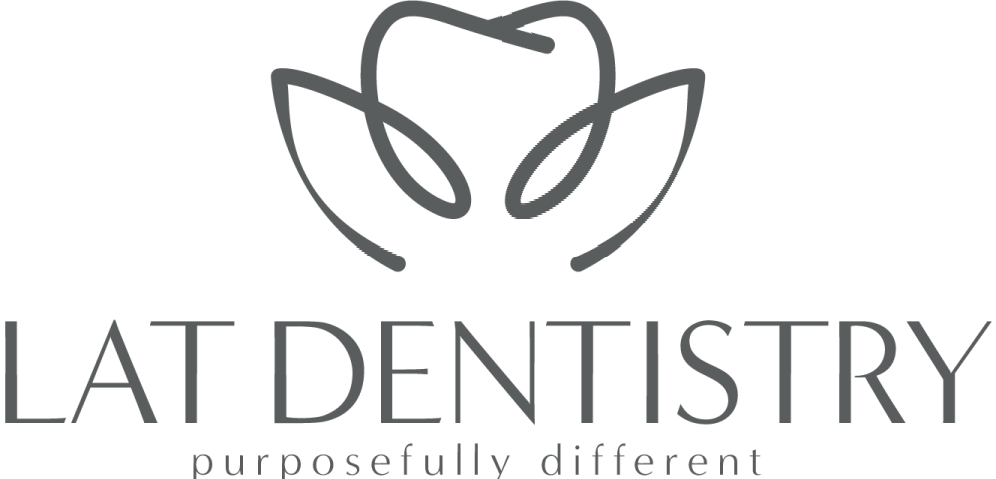Dental Myths, Busted!
Dental health is often surrounded by misconceptions that can lead to poor oral care habits or unnecessary anxiety. Let’s clear up some of the most common dental myths and set the record straight.
1. Myth: Brushing harder cleans better
Truth: Brushing with too much force can actually damage your teeth and gums. It may wear down tooth enamel and cause gum recession, which can lead to sensitivity and even cavities. The goal is to brush gently in circular motions with a soft-bristled toothbrush for at least two minutes twice a day. LAT Dentistry recommends using an electric toothbrush. Electric toothbrushes take the guesswork out of brushing. Most offer an oscillating or spinning movement, a built-in timer, and will let you know if you're pressing down with too much pressure. Invest in one, your teeth will be so thankful!
2. Myth: If my gums bleed when I floss, I should stop
Truth: Bleeding gums are often a sign of inflammation and bacterial infection caused by plaque build-up along the gumline. If your gums bleed when you floss, it’s a sign you need to floss more regularly, not less. Oftentimes you need to change how you are flossing, try the c-wrap technique. Bend your floss around your tooth as if making the shape of a 'c', then slide the floss up and down to remove plaque buildup. Over time, consistent flossing will reduce gum inflammation, and the bleeding should stop.
3. Myth: White teeth are healthy teeth
Truth: White teeth do not always mean healthy teeth, and discolored teeth aren't necessarily unhealthy. Many factors can cause teeth discoloration, such as aging, coffee or wine consumption, or medications. Healthy teeth may vary in shade and still be strong and cavity-free. The best indicator of oral health is not tooth color but regular check-ups with your dentist and proper dental hygiene.
4. Myth: I don’t need to see a dentist if my teeth don’t hurt
Truth: Oral health issues like cavities, gum disease, or tooth decay often don't cause pain in the early stages. Regular dental check-ups are crucial for detecting problems before they become painful and harder to treat. Preventative care is key to long-term dental health, avoiding costly dental problems, and keeping your teeth looking and functioning like natural!
5. Myth: Sugar is the only cause of cavities
Truth: While sugar is a major contributor to cavities, it’s not the only culprit. Starches, acidic foods, and poor oral hygiene can also lead to tooth decay. The bacteria in your mouth feed on carbohydrates, producing acid that erodes tooth enamel, leading to cavities. It's important to limit sugar, brush and floss regularly, and rinse with water after meals to keep your teeth healthy.
6. Myth: Chewing sugar-free gum is just as good as brushing
Truth: While sugar-free gum can help clean teeth by stimulating saliva production, which helps neutralize acids and wash away food particles, it’s not a substitute for brushing and flossing. Brushing removes plaque and bacteria that gum cannot. Chewing gum can be a helpful addition to your routine but should not replace brushing and flossing.
7. Myth: Baby teeth aren’t important since they fall out
Truth: Baby teeth play an essential role in your child’s development. They help with speech, chewing, and guiding permanent teeth into place. Neglecting baby teeth can lead to problems like tooth decay, which may affect the alignment of adult teeth and overall oral health. They can also harbor bad bacteria that can spread to and infect adult teeth as they come into place.
8. Myth: I don’t need to floss if I use mouthwash
Truth: Mouthwash can help reduce bacteria and freshen breath, but it cannot remove food particles or plaque from between your teeth. Flossing is essential for cleaning those hard-to-reach areas where cavities and gum disease often begin. Mouthwash is a good supplement to brushing and flossing, but not a replacement. Check out our blog to see which mouthwashes we recommend.
9. Myth: Teeth whitening damages enamel
Truth: When done correctly, professional teeth whitening treatments are safe and do not damage tooth enamel. Over-the-counter whitening products can be safe if used as directed, but overuse or improper application may lead to sensitivity or irritation. Always consult your dentist before starting any whitening treatments.
10. Myth: You can’t get cavities if you have fillings or crowns
Truth: Fillings and crowns do not make your teeth immune to cavities. They restore areas of decay but the surrounding tooth structure is still susceptible to plaque and bacteria. The same goes for a crown - although the tooth is covered with a porcelain like or metal material, there is healthy tooth structure underneath the crown and where the crown margin ends. That tooth structure is susceptible to cavities just as any other enamel is. Maintaining good oral hygiene, including brushing, flossing, and regular dental visits, is still essential after getting fillings.
11. Myth: Tooth loss is a normal part of aging
Truth: Tooth loss is not an inevitable part of aging. With proper oral care and regular dental check-ups, it’s possible to maintain healthy teeth for life. Gum disease and tooth decay, which lead to tooth loss, can be prevented through good hygiene habits, a balanced diet, and regular dental care.
12. Myth: DIY dental care (like using charcoal or baking soda) is better than store-bought products
Truth: While DIY dental trends like using activated charcoal or baking soda for teeth whitening may seem appealing, they can be abrasive and potentially damage your enamel. It’s safer to use dentist-recommended products that have been tested for safety and effectiveness.
Final Thoughts
Understanding the truth behind these common dental misconceptions is important for maintaining a healthy smile. Stick to trusted oral care practices, and consult your dentist for advice if you're unsure about any aspect of your dental routine. Remember, proper care, regular check-ups, and professional guidance are key to achieving and maintaining good oral health!

